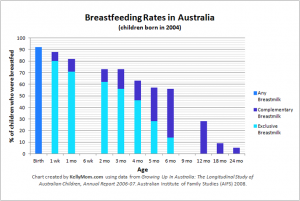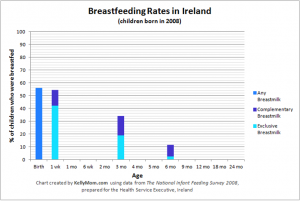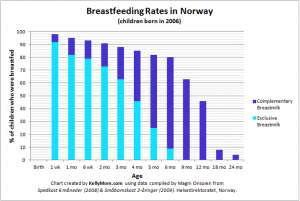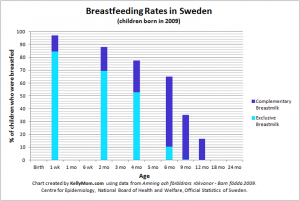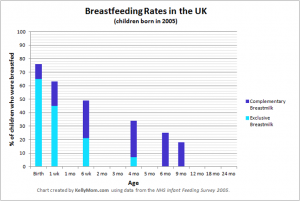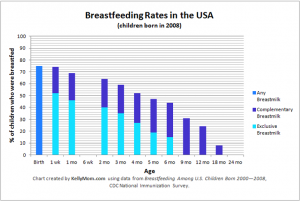Ever wonder how breastfeeding rates compare from country to country? Following are graphics showing breastfeeding rates in Australia, Canada, Sweden, the UK, and the US from 2004-2009. Click on the graphic to see a larger version.
For each country, I charted the year for which the most recent data was available. I’ll be happy to add graphics for additional countries if you provide me with a link to the breastfeeding data in the comments.
Now infants can get
all their vitamin D
from their mothers’ milk;
no drops needed with
our sponsor's
TheraNatal Lactation Complete
by THERALOGIX. Use PRC code “KELLY” for a special discount!
A little explanation of the numbers here…
- “Any Breastmilk” – Baby receives any amount of breastmilk. This could be anything between exclusive breastfeeding and being put to the breast once. Baby may be receiving other foods or liquids.
- “Complementary Breastmilk” – Baby receives both breastmilk and other foods/liquids (which could include formula, juice, solid foods, teas, water, etc.).
- “Exclusive Breastmilk” – Baby receives breastmilk only – no water, tea, formula, juice, cereal, solid foods, etc. Baby can receive drops and syrups (vitamins, minerals and medicines) and still be considered exclusively breastfed. Most babies are ready to start solid foods around 6 months of age, so the extent of exclusive breastfeeding is not often measured past 6 months.
- Breastmilk includes the mother’s own milk (either at the breast or expressed) and/or another mother’s milk (including banked milk, other donor milk, or wet nursing)
5/26/12 Update: Graphics added for Ireland and Norway.
More:
Breastfeeding: The Numbers – Breastfeeding rates in the United States and worldwide
Infant and young child feeding by country from UNICEF’s ChildInfo.org
References
Australia:
Growing Up In Australia: The Longitudinal Study of Australian Children, Annual Report 2006-07. Australian Institute of Family Studies (AIFS) 2008.
Australian National Breastfeeding Strategy 2010 – 2015.
Canada:
Statistics Canada: Breastfeeding practises by province and territory.
Breastfeeding Rates and Hospital Breastfeeding Practices in Canada: A National Survey of Women. Chalmers B, et al. Birth. 2009 Jun;36(2):122-32.
Norway (data compiled by Magni Onsoien):
Rapport: Spedkost 6 måneder (1998). Helsedirektoratet.
Rapport: Spedkost 12 måneder (1999). Helsedirektoratet.
Rapport: Spedkost 6 måneder (2008). Helsedirektoratet.
Rapport: Småbarnskost 2-åringer (2009). Helsedirektoratet.
Sweden:
Amning av barn födda 2004. Centre for Epidemiology at the National Board of Health and Welfare, Official Statistics of Sweden.
Amning och föräldrars rökvanor – Barn födda 2009. Centre for Epidemiology at the National Board of Health and Welfare, Official Statistics of Sweden.
United Kingdom:
NHS Infant Feeding Survey 2005.
NHS Infant Feeding Survey 2010: Early Results.
United States:
Breastfeeding Among U.S. Children Born 2000—2008, CDC National Immunization Survey.

